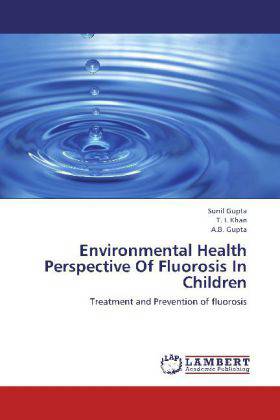
- Afhalen na 1 uur in een winkel met voorraad
- Gratis thuislevering in België vanaf € 30
- Ruim aanbod met 7 miljoen producten
- Afhalen na 1 uur in een winkel met voorraad
- Gratis thuislevering in België vanaf € 30
- Ruim aanbod met 7 miljoen producten
Zoeken
Environmental Health Perspective Of Fluorosis In Children
Treatment and Prevention of fluorosis
Sunil Gupta, T I Khan, A B Gupta
Paperback | Engels
€ 77,95
+ 155 punten
Omschrijving
High fluorides ingestion through drinking water affects the body system of human being. No treatment was successful in the children with fluorosis. This study reports successful treatment of fluorosis in children and possible preventive measures. Double blind cross sectional clinical study was conducted on 200 children consuming water containing 2.4, 4.6, 5.6 and 13.5 mg/l of fluoride of various age groups. A note was made for clinical, radiological and dental fluorosis. Biochemical estimations were made for serum calcium, serum and urinary fluoride and serum parathyroid hormone. It was observed that high Fluoride ingestion causes increased parathyroid hormone secretion, which is responsible for maintaining serum calcium levels and leading to manifestations of fluorosis. The supplementation of a therapeutic regime of Calcium, Vitamin C and Vitamin D in these children reported reversal of fluorosis, indicating that this therapy can be employed successfully in children suffering from fluorosis. For prevention, Intake of fluoride can be reduced by the use of simple defluoridation technique, reducing intake of fluoride rich items and use of food rich in calcium, Vitamin C and protein.
Specificaties
Betrokkenen
- Auteur(s):
- Uitgeverij:
Inhoud
- Aantal bladzijden:
- 220
- Taal:
- Engels
Eigenschappen
- Productcode (EAN):
- 9783659126000
- Verschijningsdatum:
- 10/06/2012
- Uitvoering:
- Paperback
- Formaat:
- Trade paperback (VS)
- Afmetingen:
- 152 mm x 229 mm
- Gewicht:
- 326 g

Alleen bij Standaard Boekhandel
+ 155 punten op je klantenkaart van Standaard Boekhandel
Beoordelingen
We publiceren alleen reviews die voldoen aan de voorwaarden voor reviews. Bekijk onze voorwaarden voor reviews.











